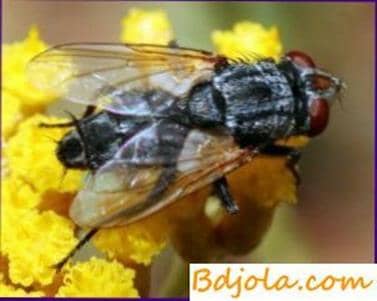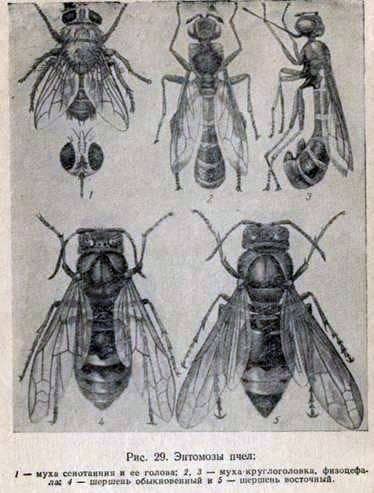
Cenotainiosis is an invasive disease that causes the death and weakening of bee colonies.
The causative agent of the disease is the parasitic Fly Seno-tainia tricuspis. Female flies of cenotainia have a length of 6-8 mm, an ash-gray color with wide white strips on the head.

The second tergite of the abdomen has two long setae in the middle of the posterior margin. The head is covered with long hairs, giving it a white color. Tentacles and anterior part of head yellow. The third antennal segment is twice as long as the second.
Males and young female flies live outside the apiary. Fertilized same females for days on end are in the apiary. They sit on the sunny side of the hive, often on the roof. Females, while having a fast flight, creating a characteristic sound, overtake the bees leaving the hive and infect them with their larvae.
Sinotainia is very prolific. In the abdomen of one female senotainia, there are from 100 to 631 larvae. The larvae extracted from the ovaries of the flies of senotainia have a length of 0.7-0.8 mm, a width of 0.17 mm in the middle, and taper to 0.04 mm toward the anterior end.
The body of the larva consists of 12 segments. The surface of the larva is covered with triangular spines directed backwards, which are clearly distinguishable on the first two segments. Larvae in the middle stage of development have a body 2-5 mm in length. Postponed on the bee, in the area of the articulation of the head and chest, the fly’s larva penetrates into the thoracic cavity through the back surface of the coarse bundle, which is exposed during flight of the bee. In the chest cavity the larva develops and reaches maturity, has a length of 11-15 mm and a width of 3 mm.
The bulk of the invasive bees die within the first 10 days after the invasion. Only a part of the larvae of the senotaini develop slowly in the body of the bee, being in a diapause, due to which the invaded bee lives for a longer period of time. The mature larva emerges from the corpse of the bee through the cephalic joint or through the passages done in any other part of the body of the bee.
Reached larvae burrow into the soil to a depth of several centimeters and pupate for 1-3 days. The outer covering of the pupating larva acquires a brownish-reddish color, compacts to 0.5 X 0.8 mm, and turns into a puparia; the pupa is barrel-shaped. The pupa stage lasts 7-12 days. The general cycle of development of the flies of cenotainia lasts from 15 to 35 days. Over the summer, flies are given at least two generations. Hibernate, flies in the form of a puparium in the ground at a depth of up to 20 cm.
The degree of resistance of the parasite in the various stages of development of senotainia has not been studied.
Cenotainia have high pathogenicity. Infected bee pickers die after 2-9 days, in most cases (80%) after four days. The speed of death depends to a large extent on the number of larvae deposited in the cavity of the bee. Often find in the body of bees 2-3, rarely 4-6 and very rarely 7-8 larvae. Cenotainiosis is found in bumble bees: Bombus terrestris, Bombus lapidarius and Bombus muscorum L., and a single bee Halictus.
Epizootic data. The primary source of infection of bees with cenotainiosis are the habitats of flies of cenotainia. She settles more often on the fringes of forests, mostly pine.
The course and symptoms of the disease. Cenotainiosis occurs from June to September, but reaches its peak in the second half of July and August, and then gradually declines. The most affected families are their nests located in the sun, as well as weaker families. Intensive development of the disease occurs when the second and third generation of flies of senotainia appear. Most flying bees die outside the apiary. A few dead bees are found on predelovyh areas.
An increase in the death of bees is observed after non-flying weather. Bees pickers lose the ability to fly. Creeping and jumping bees appear on the ground with “dragging” wings (a characteristic feature). Sick bees do not recover. Larvae of cenotaini continue to develop in the corpses of bees. As a consequence, there are sometimes signs of life (changes in abdominal volume, flinches) among dead bees.
The diagnosis of cenotainiosis is based on the detection of flies of cenotaini on fly apiaries and when the larvae of a fly fly in the chest cavity of diseased and dead bees. Samples of bees for research are sent in alcohol or honey.
Control measures. Destruction of adult flies is the main measure in the fight against cenotainiosis.
On an apiary, sick and dead bees are collected daily and burned. To collect the larvae of cenotaini on the apiary, small pits with a depth of about 20 cm are made. Cereals creeping along the ground crawl along the ground with bees, from where they are daily extracted and destroyed.
Пчела-каменщица. Весенняя чистка улья.
Diseases of bees